|
|
Modal Verbs printable
worksheets, powerpoints and online exercises
order results:
most downloaded first
-
newest first
|
Worksheets |
Powerpoints |
Online exercises |
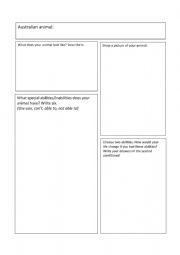
Australian animals ESL
Level: intermediate
Age: 12-100
Type:

Past Tense: Modals of Regret vs. Statements
The first page is an overview/explanation of the grammar point (it is a spoiler for the exercises - the exercises should be done first after an explanation and practice by the teacher).
The second page gives 2 exercises with individual corresponding to the first page examples.
The third pages has all the answers to the exercises on it.
Level: intermediate
Age: 13-100
Type: worksheet

Modal verb
Modal verb of obligation
Level: intermediate
Age: 12-100
Type:

Should
Level: intermediate
Age: 13-100
Type:
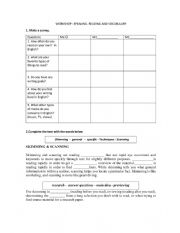
SKIMMING AND SCANNING
THIS WORKSHOP HELP STUDENT TO PRACTICE SPEAKING, SKIMMING AND SCANNING.
Level: elementary
Age: 11-16
Type:
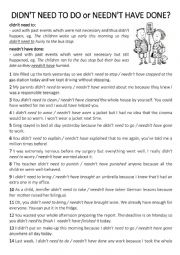
Didn�t Need to Do or Needn�t Have Done?
Brief explanation and 25 fairly simple sentences to practice the difference between didn�t need to and needn�t have.
Level: advanced
Age: 13-100
Type:

Modals - Possibility or Probability
Activity to practice modals of probability or possibility using may, might, could, must and can�t. Key included
Level: intermediate
Age: 14-100
Type:
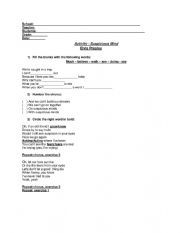
Song: Elvis Presley: Suspicious Minds
You can use this worksheet to work can/can�t
Level: elementary
Age: 14-100
Type:

Inversion
INVERSION theory and practice
Level: intermediate
Age: 11-100
Type:
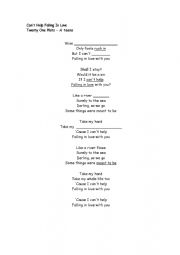
Can�t hel falling in love - twenty one pilots
Level: intermediate
Age: 13-100
Type:

social signs 2
These instruction are also included inside the worksheet.
Signs and Symbols � Instructions
This is a set of colour cards depicting common signs and symbols used in this country and internationally.
So me of the signs are pairs of opposites, others are pictogrammes to be matched to a corresponding caption and others are self-explanatory. Learners...
Level: elementary
Age: 10-100
Type:
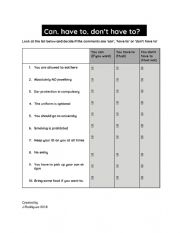
Can, Have to or don�t have to?
Using Can, Have to and Don�t have to for rules
Level: intermediate
Age: 12-100
Type:
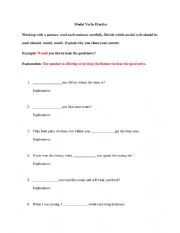
Modals Practice (Should, Would, Could)
Level: intermediate
Age: 7-100
Type:
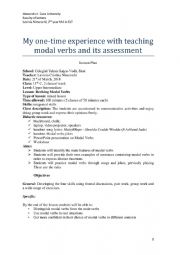
My one time experience with teaching modal verbs
Level: advanced
Age: 15-100
Type:

Chlorine 21 Pilots Activity Handout
With this complicated lyrics, students have the chance to come up with deductions about possible meanings and reasons the authors may have had when writing the song. Students have to discuss about possible meanings in small groups trying to politely interruopt other and at the same time trying to stick to their topics or ideas.
Level: advanced
Age: 15-100
Type:
|

SUPERHEROES ABILITIES
I USED THIS PPT TO INTRODUCE CAN CANT
Level: elementary
Age: 8-17
Format: PowerPoint

Can and Could PPT
A brief PPT for elementar and pre-int. to practice can and could.
Level: elementary
Age: 7-17
Format: PowerPoint

Modal verbs of logical assumption
This is a ppt presentation that works well during the practice stage (modals of logical assumption/speculati on). Students should look at the picture and answer questions, using modal verbs of logical assumption.
Level: intermediate
Age: 12-17
Format: PowerPoint

Philip�s driving lesson
Let your students be Philip�s driving instructor!!! Click, a bubble with a road sign in it appears.Students must react and give the instruction aloud as if they were the driving instructor.Click again to check and you get the written instruction.I hope your students will have a nice time.
Level: elementary
Age: 11-17
Format: PowerPoint

May - Might (Possibility)
It explains the difference between may and might. Besides, it includes a short exercise.
Level: intermediate
Age: 10-17
Format: PowerPoint

Giving Advices
Practice different ways of giving advices.
Level: intermediate
Age: 10-17
Format: PowerPoint

could-couldn�t
a very useful ppt about past habits
Level: elementary
Age: 10-17
Format: PowerPoint

Modals (Part 2)
modals part 2
should shouldn�t have to can ...
Level: elementary
Age: 10-17
Format: PowerPoint

Must, mustn�t, have to, should and shouldn�t
It�s a tamplate to explain prohibition, obligation, necessity and recommandation with the modal verbs should, must and the verb have to.
Level: intermediate
Age: 14-17
Format: PowerPoint

What can he do?
A power point presentation for practising asking and answering questions with "can/ can�t"
Level: elementary
Age: 14-17
Format: PowerPoint

Can you guess the object?
Students will have to use modals of deduction in order to guess the object. Try it with your students! They�ll have lots of fun!
Level: intermediate
Age: 14-17
Format: PowerPoint

Modals (Part 1)
modals
Level: elementary
Age: 10-17
Format: PowerPoint

modal verbs
it�s about the modals verbs. it�ll help you to use these verbs.
Level: elementary
Age: 14-17
Format: PowerPoint

Modal verbs
Two simple exercises on the modal verbs.
Level: elementary
Age: 11-17
Format: PowerPoint

Learning situations
Learn modals verbs through school rules and road sings.
Level: elementary
Age: 10-17
Format: PowerPoint
|
|
Page:
[<<
previous ]
1
2
3
4
5
6
7
8
9
10
11
12
13
14
15
16
17
18
19
20
21
22
23
24
25
26
27
28
29
30
31
32
33
34
35
36
37
38
39
40
41
42
43
44
45
46
47
48
49
50
51
52
53
54
55
56
57
58
59
60
61
62
63
64
65
66
67
68
69
70
71
72
73
74
75
76
77
78
79
80
81
82
83
84
85
86
87
88
89
90
91
92
93
94
95
96
97
98
99
100
101
102
103
104
105
106
107
108
109
110
111
112
113
114
115
116
117
118
119
120
121
122
123
124
125
126
127
128
129
130
131
132
133
134
135
136
137
138
139
140
141
142
143
144
145
146
147
148
149
150
151
152
153
154
155
156
157
158
159
160
161
162
163
164
165
166
167
168
169
170
171
172
173
174
175
176
177
178
179
180
181
182
183
184
185
186
187
188
189
190
191
192
193
194
195
196
197
198
199
200
201
202
203
204
205
206
207
208
209
210
211
212
213
214
215
216
217
218
219
220
221
222
223
224
225
226
227
228
229
230
231
232
233
234
235
236
237
238
239
240
241
242
243
244
245
246
247
248
249
250
251
252
253
254
255
256
257
258
259
260
261
262
263
264
265
266
267
268
269
270
271
272
273
274
275
276
277
278
279
280
281
282
283
284
285
286
287
288
289
290
291
292
293
294
295
296
297
298
299
300
301
302
303
304
305
306
307
308
309
310
311
312
313
314
315
316
317
318
319
320
321
322
323
324
325
326
327
328
329
330
331
332
333
334
335
336
337
338
339
340
341
342
343
344
345
346
347
348
349
350
351
352
353
354
355
356
357
358
359
360
361
362
363
364
365
366
367
368
369
370
371
372
373
374
375
376
377
378
379
380
381
382
383
384
385
386
387
388
389
390
391
392
393
394
395
396
397
398
399
400
401
402
403
404
[
Next
>>]
|

Live Worksheets
Worksheets that listen.
Worksheets that speak.
Worksheets that motivate students.
Worksheets that save paper, ink and time.
Advertise here
|